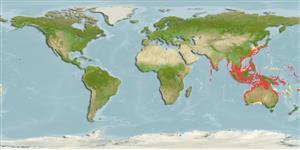Common names from other countries
Environment: milieu / climate zone / depth range / distribution range
Ecologia
; estuarina; intervalo de profundidade 8 - 95 m (Ref. 8), usually 20 - 60 m (Ref. 409). Tropical; 36°N - 35°S, 72°E - 165°W
Indo-West Pacific.
Length at first maturity / Tamanho / Peso / Idade
Maturity: Lm ?, range 4 - ? cm Max length : 15.4 cm BL macho/indeterminado; (Ref. 409); 18.9 cm BL (female); Peso máx. publicado: 18.00 g (Ref. 116487)
Maximum carapace length: 3.5 cm (male); 4.2 cm (female) (Ref. 8). Common body length: 7.0 to 14.0 cm (Ref. 409). Minimum depth range from Ref. 111048. Subtidal (Ref. 106854). Found mainly in turbid waters down to a depth of 95 m over bottoms of mud, sandy-mud or silt. Juveniles are found in estuaries and backwaters, also in seagrass beds, mangrove banks, mud flats, and open channels (Ref. 8) while adults are found in deeper waters (Ref. 10). Juveniles from a riverine mangrove are likely to obtain nutrition from phytoplankton and possibly epiphytic algae than from mangrove leaves or detritus (Ref. 105141). Omnivore (Ref. 116259).
Life cycle and mating behavior
Maturidade | Reprodução | Desova | Ovos | Fecundidade | Larvas
Members of the order Decapoda are mostly gonochoric. Mating behavior: Precopulatory courtship ritual is common (through olfactory and tactile cues); usually indirect sperm transfer.
Holthuis, L.B. 1980. (Ref. 8)
Status na Lista Vermelha da IUCN (Ref. 130435)
Status no CITES (Ref. 108899)
Not Evaluated
Not Evaluated
Uso pelos humanos
Pescarias: altamente comercial; isca: occasionally
FAO - Aquacultura: produção; | FishSource | Sea Around Us
Ferramentas
Fontes da internet
Estimates based on models
Preferred temperature
(Ref.
115969): 24.2 - 29.1, mean 28.1 (based on 1590 cells).
Resiliência
Elevada, tempo mínimo de duplicação da população menor que 15 meses (K=1.49-1.52).
Vulnerabilidade
Low vulnerability (10 of 100).
